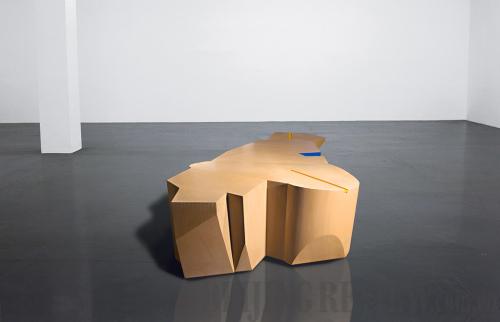|
 |
|
AVANT-GARDE ART: An exhibition tilted Wang Jianwei: Time Temple showcases the Chinese artist's works at the Solomon R. Guggenheim Museum, New York City, from October 31, 2014 through February 16, 2015 (FILE) |
There is a certain sense of alarm the viewer feels in the work of Beijing-based artist Wang Jianwei. One is never quite on solid ground. The tension of the moment, of potential crisis, looms and resonates in your psyche. Spiral Ramp Library--a live art performance conceived as the closing ceremony of the exhibition and commission Wang Jianwei: Time Temple at New York's Guggenheim Museum--is based on recordings from the exhibit's opening performance, in which 20 orators spoke on 10 topics: disappearance, Gnosticism, library, map, universe, climate, Jorge Luis Borges, Argentina, Frank Lloyd Wright, and the Guggenheim.
Spiral Ramp Library is disconcerting and spooky, morbid and enduring. The work lodges itself into your brain. Four dancers move about the small stage with blank expressions, disconnected from one another and disconnected from the viewer. Chapters of the performances are divided with a video of a man falling slowly from the top of what appears to be a Beijing residential high-rise, pausing at various windows to witness the tableaus inside.
Wang Jianwei, one of China's most important conceptual artists, views theater as an important strategy for opening up a conversation with the audience in a "communal moment of the staged event," say Guggenheim organizers.
"We can think of Spiral Ramp Library as a sort of 'occupation' in a sense, a temporary self-governing of space," Wang says.
The performance is part an "evolving rehearsal" that does not adhere to a particular style, says the artist.
"Spiral Ramp Library is a rehearsal that indirectly and repeatedly acts upon the existing order. Here the library is a metaphor for a structurally complete, seemingly objective system of knowledge," he says. "We will keep all things in the course of process. Things in the course of process are uncertain, juxtaposed, and hard to position."
This uncertainty is evident in Time Temple, the artist's installation at the Guggenheim. In a video Wang made about the work, he describes the process as changes that take place during different periods of time.
"For example, the production of works as time, the exhibition cycle as time, and the audience's viewing experience in different locations as time," he says. The exhibition consisted of a room of paintings and sculptures; the 55-minute film The Morning Time Disappeared, inspired by Franz Kafka's Metamorphosis; and finale performance event.
The delicate balance of each element to the exhibition has been compared to the precarious equilibrium of a Chinese puzzle. The paintings vary from abstract composition to photo-realist depictions of subdued men and women in dark suits sitting around a long empty table. The paintings are tense, serious and strange. The sculpted objects have no purpose, and sit lonely and disconnected in the gallery. The opening performance, which Spiral Ramp Library drew its material from, gathered 20 people to speak simultaneously on various topics, their voices echoing around the spiral ramp that snakes its way up the Frank Lloyd Wright-designed museum. The cacophony evokes Jorge Luis Borges' Library of Babel--a repository of texts, knowledge and thought. Some of which are profound, and others purely nonsense.
"As the performance unfolds there is an emphasis on the unstable, the unpredictable and the uncertain aspects of actions into the life, and into the space, time and context of the performance," says Thomas J. Berghuis, Robert H. N. Ho Family Foundation Curator of Chinese Art.
The film clips used in the performance of Spiral Ramp Library evoke "the predictament of the present moment," Berghuis says, "located somewhere between past and future, between life and death. A time when everything is in a state of flux and uncertain."
The scattered fragments of information and emotion presented in Spiral Ramp Library leave the viewer to organize and decipher. Life and the meaning of life are uncertain, and this uncertainty "drives the performance," Berghuis says.
The installation of Time Temple and the performance of Spiral Ramp Library are part of a 2013 initiative by the Guggenheim Museum to advance contemporary Chinese art through a grant of the Robert H.N. Ho Family Foundation. The grant is aimed to commission new works from artists from the Chinese mainland, Taiwan, Hong Kong and Macao and to include some of these works into the permanent collection at the Guggenheim. The program is set to continue through 2017, and offer publications, lecture series, educational programs and public interactions with contributing artists.
"The presentation of Time Temple is a significant step forward for the Guggenheim's Asian Art Initiative, which has been expanding our network of relationships, our base of knowledge, and our collecting since 2006," says Richard Armstrong, Director of the Solomon R. Guggenheim Museum and Foundation, in a statement.
The author is a contributing writer to Beijing Review, living in New York City |
